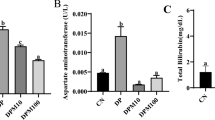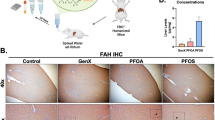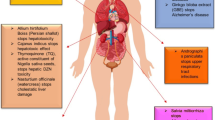Abstract
Lead (Pb) poisoning is one of the pivotal environmental issues and prompts liver dysfunction by elevating oxidative stress and inflammation. Nicotinamide (NA) deficiency enhances sensitivity to Pb toxicity. So, we investigated the effect of nicotinamide (NA) on the rat’s liver histopathological and biochemical profiles in a rat model of Pb toxicity. Thirty-six rats were divided into four groups (nine rats at each): normal (N), lead toxicity (Pbt), and NA-treated N and Pbt groups. Treated groups took NA (180 mg/L in drinking water for one month). Pb intoxication was motivated in rats by acquiring 50 mg/L lead acetate in drinking water. Oxidative stress markers (advanced oxidation protein products and malondialdehyde), antioxidant markers (total glutathione, reduced glutathione to oxidized glutathione ratio, ferric ion reducing power, catalase, and paraoxonase-1), and inflammatory markers (hepatic nuclear factor-kβ expression, interleukin 1β level, and myeloperoxidase activity) in sera and liver homogenates were determined. In addition, the biochemical parameters of the liver function were measured. Finally, the liver of rats was evaluated by histopathological observation. NA corrected lead-persuaded biochemical and histopathological changes in the rat’s liver. In addition, treatment decreased Pb, oxidative stress, and inflammatory markers in the sera and liver homogenates of N and Pbt groups. In addition, it elevated antioxidant markers (p < 0.001). NA prevented Pb-induced liver histopathological alternations and reduced liver dysfunction by reducing Pb, oxidative stress, and inflammation. Moreover, raising GSH/GSSG and diminishing the hepatic NF-kβ pathway are cardinal mechanisms of the treatment against Pb-motivated hepatotoxicity in rats.


Similar content being viewed by others
References
Mahar FK, He L, Wei K, Mehdi M, Zhu M, Gu J, Zhang K, Khatri Z, Kim I (2019) Rapid adsorption of lead ions using porous carbon nanofibers. Chemosphere 225:360–367
Flora SJ, Pachauri V (2010) Chelation in metal intoxication. Int J Environ Res Public Health 7(7):2745–2788
Mohamed RS, Fouda K, Akl EM (2020) Hepatorenal protective effect of flaxseed protein isolate incorporated in lemon juice against lead toxicity in rats. Toxicol Rep 7:30–35
Fehaid A, Al‐Ghamdi MS, Alzahrani KJ, Theyab A, Al-Amer OM, Al-Shehri SS, Algahtani M, AA AO, Alnfiai MM, Aly MH, Alsharif KF, Albrakati A, Kassab RB, Althagafi HA, Alharthi F, Abdel Moneim AE, Lokman MS (2023) Apigenin protects from hepatorenal damage caused by lead acetate in rats. J Biochem Mol Toxicol 37(3):e23275
Mansour LAH, Elshopakey GE, Abdelhamid FM, Albukhari TA, Almehmadi SJ, Refaat B, El-Boshy M, Risha EF (2023) Hepatoprotective and neuroprotective effects of naringenin against lead-induced oxidative stress, inflammation, and apoptosis in rats. Biomedicines 3(11):1080
Mesalam NM, Ibrahim MA, Mousa MR, Said NM (2023) Selenium and vitamin E ameliorate lead acetate-induced hepatotoxicity in rats via suppression of oxidative stress, mRNA of heat shock proteins, and NF-kB production. J Trace Elem Med Biol 79:127256
Shalan MG, Al-Bakry NA, Rashwan HM (2023) The ameliorative effects of lactoferrin against lead acetate toxicity in female albino rat. Egypt J Zoology 80:35–49
Mahdavifard S, Sekhavatmand N (2022) Glutamine is a superior protector against lead-induced hepatotoxicity in rats via antioxidant, anti-inflammatory, and chelating properties. Biol Trace Elem Res 200(11):4726–4732
Peraza MA, Ayala-Fierro F, Barber DS, Casarez E, Rael LT (1998) Effects of micronutrients on metal toxicity Marjorie Rael. Environ Health Perspect 106:203–216
Flora SJ, Tandon SK (1987) Influence of dietary deficiency of nicotinamide on lead toxicity in young rats. Biol Trace Elem Res 14:143–151
Lanska DJ (2010) Chapter 30: historical aspects of the major neurological vitamin deficiency disorders: the water-soluble B vitamins. Handb Clin Neurol 95:445–476
Brown AP, Dinger N, Levine BS (2000) Stress produced by gavage administration in the rat. Contemp Top Lab Anim Sci 39(1):17–21
Sun B, Karin M (2008) NF-kB signaling, liver disease and hepatoprotective agents. Oncogene 27:6228–6244
Akbudak İH, Kilic Erkek O, Tuzcu EB, Pakyurek H, Bor Kucukatay M (2021) Ketamine/xylazine anesthesia is safe in hemorheological point of view: a preliminary report. Pamukkale Tıp Dergisi 14(2):444–450
Parasuraman S, Raveendran R, Kesavan R (2010) Blood sample collection in small laboratory animals. J Pharmacol Pharmacother 1(2):87–93
Begic A et al (2017) The simple isocratic HPLC—UV method for the simultaneous determination of reduced and oxidized glutathione in animal tissue. Acta Chromatogr 29(1):67–84
D'souza D, Subhas BG, Shetty SR, Balan P (2012) Estimation of serum malondialdehyde in potentially malignant disorders and post-antioxidant treated patients: a biochemical study. Contemp Clin Dent 4:448–451
Taylor EL, Armstrong KR, Perrett D, Hattersley AT, Winyard PG (2015) Optimisation of an advanced oxidation protein products assay: its application to studies of oxidative stress in diabetes mellitus. Oxidative Med Cell Longev 2015:496271
Benzie IF, Strain J (1996) The ferric reducing ability of plasma (FRAP) as a measure of “antioxidant power”: the FRAP assay. Anal Biochem 239(1):70–76
Ceron JJ et al (2014) Serum paraoxonase 1 (PON1) measurement: an update. BMC Vet Res 10:74
Aebi H (1984) Catalase in vitro. Methods Enzymol 105:121–129
Chen C, Lin B, Qi S, He J, Zheng H (2019) Protective effects of salidroside on lead acetate-induced oxidative stress and hepatotoxicity in Sprague-Dawley rats. Biol Trace Elem Res 191:426–434
Gehrke N, Schattenberg JM (2020) Metabolic inflammation-a role for hepatic inflammatory pathways as drivers of comorbidities in nonalcoholic fatty liver disease? Gastroenterology 158(7):1929–1947.e6
Gao D, Madi M, Ding C, Fok M, Steele T, Ford C et al (2014) Interleukin-1beta mediates macrophage-induced impairment of insulin signaling in human primary adipocytes. Am J Phys Endocrinol Metab 307:289–304
Demir M et al (2007) Liver lipid peroxidation in experimental Escherichia coli peritonitis: the role of myeloperoxidase and nitric oxide inhibition. Med Sci Monit 13(10):Br225–Br229
Hsu JM (1981) Lead toxicity as related to glutathione metabolism. J Nutr 111(1):26–33
Yıldırım A, Aslan Ş, Ocak T, Yıldırım S, Kara F, Şahin YN (2007) Serum paraoxonase/arylesterase activities and malondialdehyde levels in trauma patients. EAJM 39:85–88
Sharma V, Kansal L, Sharma A (2010) Prophylactic efficacy of Coriandrum sativum (coriander) on testis of lead-exposed mice. Biol Trace Elem Res 36:337–354
Mohamed OI, El-Nahas AF, El-Sayed YS, Ashry KM (2016) Ginger extract modulates Pb-induced hepatic oxidative stress and expression of antioxidant gene transcripts in rat liver. Pharm Biol 54:1164–1172
Narjes Beheshti FG, Sepehri H (2015) Effect of vitamin C and quercetin treatment on the liver histopathologic profile in congenital lead exposed male rat pups. Physiol Pharmacol 10:46–52
Tupe RS, Tupe SG, Agte VV (2011) Dietary nicotinic acid supplementation improves hepatic zinc uptake and offers hepatoprotection against oxidative damage. Br J Nutr 105(12):1741–1749
Cho KH, Kim H, Rodriguez-Iturbe B, Vaziri ND (2009) Niacin ameliorates oxidative stress, inflammation, proteinuria, and hypertension in rats with chronic renal failure. Am J Physiol Ren Physiol 297(1):106–113
Acknowledgements
The results explained in this paper were part of the student thesis.
Funding
The authors are thankful to Ardabil University of medical sciences for financial support.
Author information
Authors and Affiliations
Contributions
1) Study plan, evaluation and exegesis of data: Mahdavifard & Shahi
2) Manuscript writing and revising: Mahdavifard
3) Ultimate sanction of the version to be submitted and any revised version: Mahdavifard & Shahi
Corresponding author
Ethics declarations
Ethics Approval
Ethics assent and written informed consent have been attained.
Competing Interests
The authors declare no competing interests.
Additional information
Publisher’s Note
Springer Nature remains neutral with regard to jurisdictional claims in published maps and institutional affiliations.
The survey is a genuine study that has not been lately sent to or admitted by any other journal that has been ratified.
Rights and permissions
Springer Nature or its licensor (e.g. a society or other partner) holds exclusive rights to this article under a publishing agreement with the author(s) or other rightsholder(s); author self-archiving of the accepted manuscript version of this article is solely governed by the terms of such publishing agreement and applicable law.
About this article
Cite this article
Mahdavifard, S., Shahi, Z. Hepatoprotective Effect of Nicotinamide Versus Lead-Motivated Hepatotoxicity in Rats via Correcting Effect on Nuclear Factor-kβ Pathway and Glutathione Metabolism. Biol Trace Elem Res (2023). https://doi.org/10.1007/s12011-023-03980-x
Received:
Accepted:
Published:
DOI: https://doi.org/10.1007/s12011-023-03980-x




